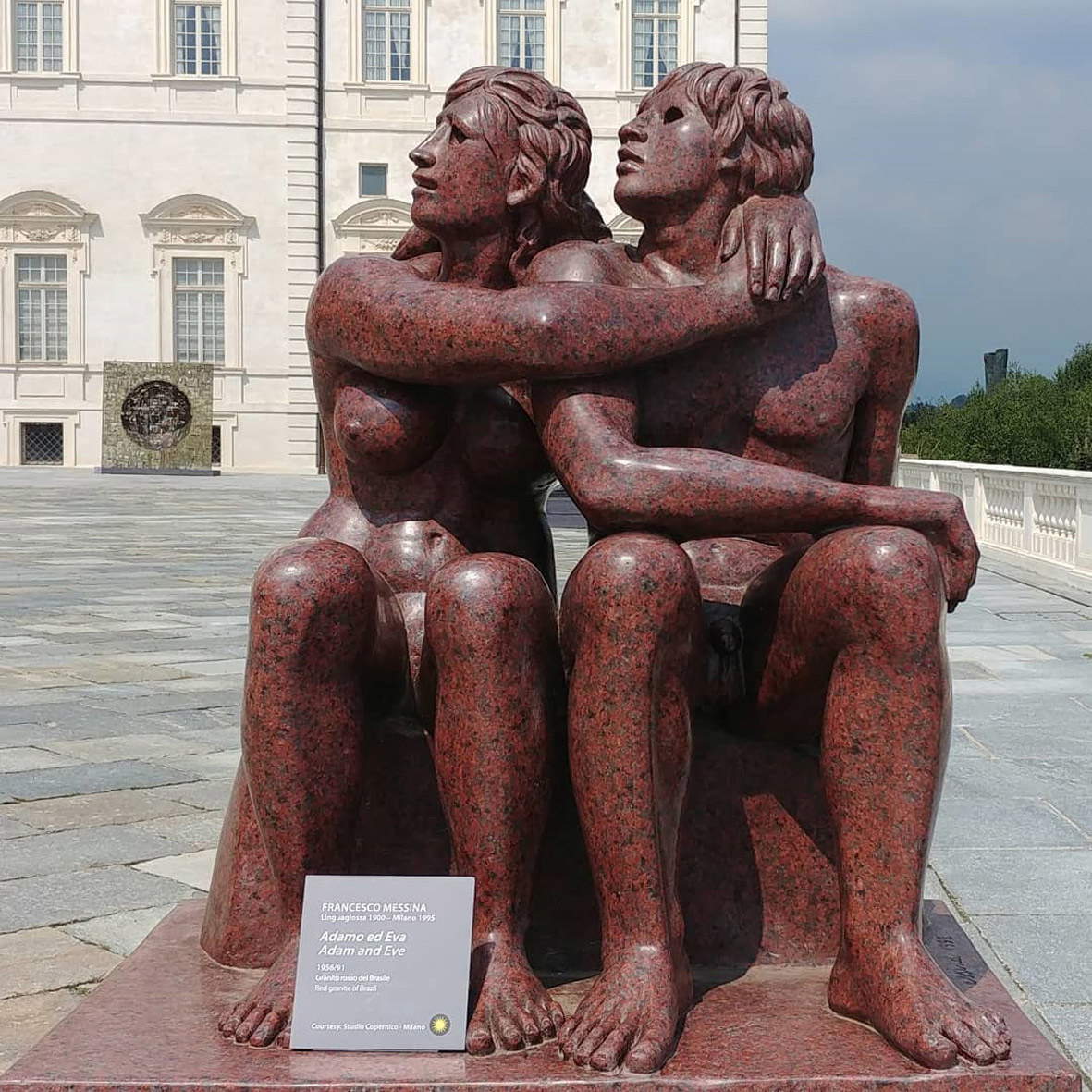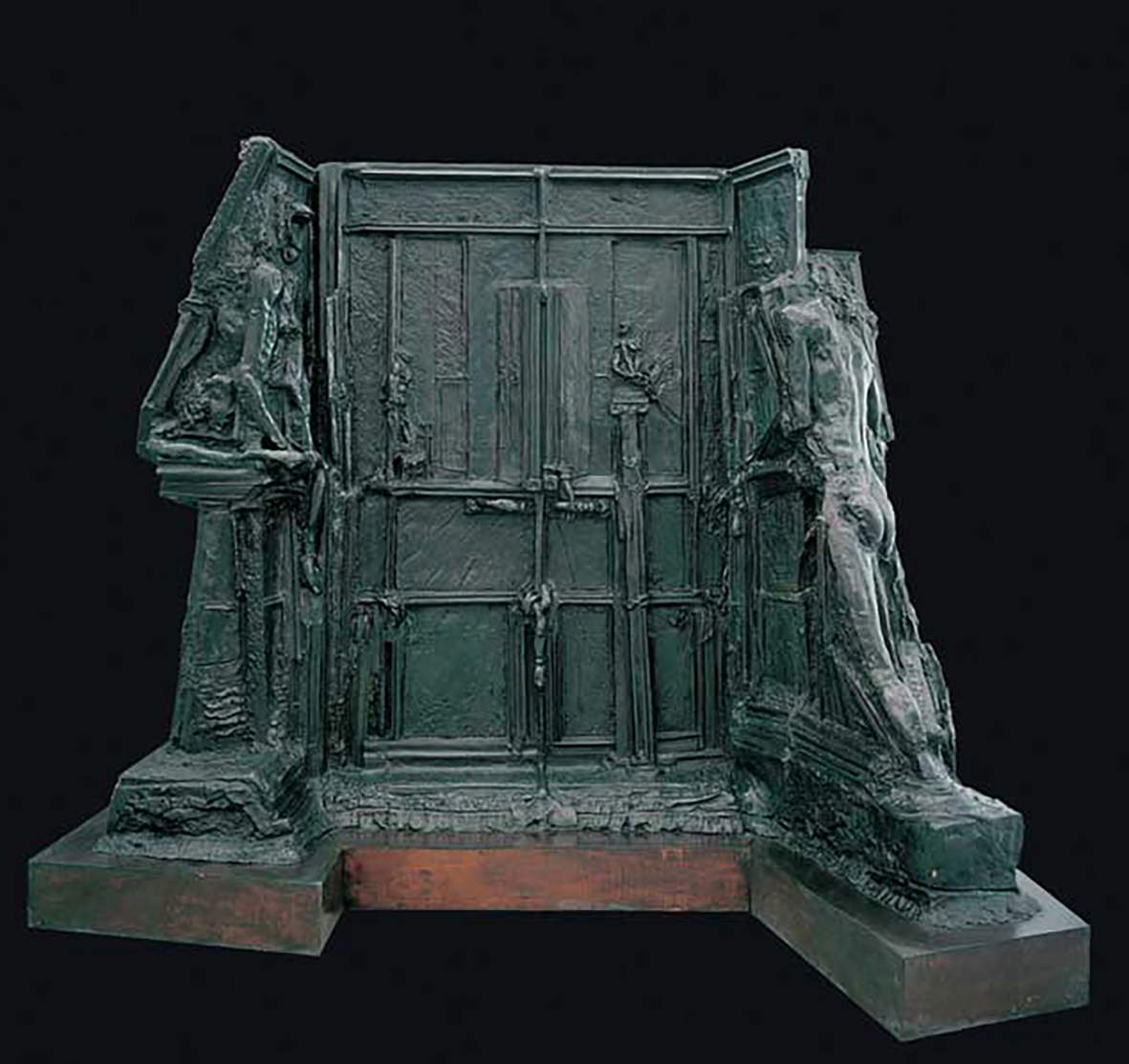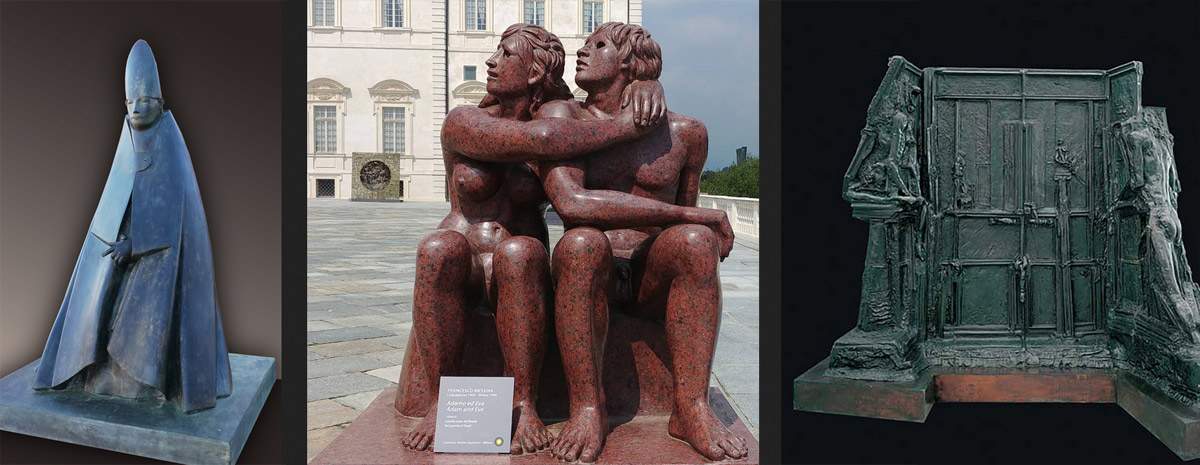Jesolo aspires to become one of the capitals of great 20th-century sculpture this summer 2019. Thanks to a project of the FAIarte Cultural Association in collaboration with the Municipality of Jesolo, the squares of the Venetian city, starting in June and running until Sept. 30, 2019, saw the arrival of eight monumental sculptures by three great artists of the 20th century: Giacomo Manzù (Bergamo, 1908 - Rome, 1991), Francesco Messina (Linguaglossa, 1900 - Milan, 1995) and Augusto Perez (Messina, 1929 - Naples, 2000). The exhibition of the three artists, titled MMP Manzù Messina Perez, is curated by Alberto Fiz, one of Italy’s leading art critics, and is part of the exhibition project titled Interesting Times for Our History, which features the artistic direction of Andrea Vizzini.
The works will remain in Jesolo for three months: among others, the public will be able to admire Manzù’s The Seated Great Cardinal, a bronze work more than two meters high; Messina’s Adam and Eve, in red granite; and La Notte (Oedipus and Sphinx), a black bronze door by Perez that stretches nearly four meters. The Great Cardinal offers the public one of Manzù’s best-known subjects: that of the cardinals, still the most recognizable strand of his research, to the point that it may have overshadowed other aspects of his production. These are solemn figures that struck Manzù as a very young man when he attended a service at St. Peter’s Basilica in Rome in 1934: from that moment the theme of cardinals entered his art never to leave it again. These are works that investigate volume and form, but also the relationship of the body to space, religiosity, and the rhetoric of official sculpture. Messina’s Adam and Eve is a subject that falls within a vein much frequented by the Sicilian sculptor: in this case, Messina completely reworks the traditional iconography, subverting it, and depicting the two progenitors side by side, embraced, as lovers looking skyward, meditating on the present. Instead, with his La Notte (Oedipus and Sphinx), Perez reaches high heights of drama with a work that introduces the viewer inside his art, in a kind of cave where each element opens a scenario of infinite possibilities involving the fate of the sculpture with historical and mythological implications. “The door,” Perez himself had written about this work, “became a labyrinth. Oedipus and the Sphinx see on the door themselves and even the door.”
 |
| Giacomo Manzù, Cardinal (bronze, 140 x 100 x 300 cm) |
 |
| Francesco Messina, Adam and Eve (granite, 200 x 150 cm) |
 |
| Augusto Perez, The Night (Oedipus and the Sphinx) (bronze, 350 x 134 x 274 cm) |
Alberto Fiz has selected works of great expressive power, capable of establishing a profound dialogue with the public space, and at the same time creating an intimate relationship between them, in a path that is intended to be unusual. Unusual also because the project intends to establish a bridge with the Venice Biennale: the title of the project, Interesting Times for Our History (which then sees a subsequent articulation, opening on July 14 with the exhibition, again in the city squares, of sculptures by two contemporary artists, Giacinto Bosco and Bruno Lucchi, under the curatorship of Boris Brollo), echoes the May you live in interesting times of the fifty-eighth edition of the Venice International Exhibition. In which, in the past, all three featured artists participated in Jesolo. The exhibition on the Lido is thus also an opportunity to review the latest events in contemporary art in Italy.
“Our recent artistic history,” Alberto Fiz points out, "is the subject of an intense debate characterized by a rather schizophrenic attitude that oscillates between oblivion and glittering recoveries. In the latter case, it is enough to recall the recent success of Carol Rama in Italy or the real adoration towards the 90-year-old Yayoi Kusama who has even become a social phenomenon. As for the historic Venetian event, Manzù, Messina and Perez were, in different years, acclaimed protagonists. There was one occasion in which they were simultaneously present: it was the 1956 edition, during which Manzù and Messina were given a solo exhibition (an edition in which Arnaldo Pomodoro, Pietro Consagra, and Emilio Greco also exhibited, and Emilio Greco won first prize for sculpture), while the then 27-year-old Augusto Perez was admitted by competition with the large, lost plaster Woman on a Bicycle. Nearly the same age as Messina and Manzù, younger than them Perez, who was an admirer of Manzù, the three artists share a restless figuration and an overall rethinking of the image that eschews any form of easy complacency." The aim, then, is to allow a rereading of the work of Manzù, Messina and Perez in an unprecedented and unprejudiced context.
However, the project also aims to place Jesolo at the center of reflections on art, offering an area known for its scenic beauty and its purely seaside tourism the possibility of a dialogue with contemporary art. The desire is to redesign the city’s image “through the encounter with art,” Vizzini stresses, “which goes to occupy various sites and creates a ’new and different’ with respect to emotions and personal experience.” Jesolo, moreover, does not host museums, and the organizers of the event therefore thought of turning its squares into museums. “Manzù, Messina and Perez,” Vizzini further explains, "one is accustomed to admiring them in museums, Francesco Messina for example at the Hermitage in St. Petersburg has dedicated rooms of about 40 works of sculpture and as many of graphics; Giacomo Manzù in New York, in front of the UN headquarters makes a fine show of his last great achievement, a bronze sculpture 6 meters high. Perez, is represented in numerous public places, including the Gallery of the Academy of Fine Arts in Naples and the Sculpture Park, a controversial and reclusive artist, was listed by critics as one of the top five Italian artists, along with Alberto Burri, Mario Schifano, Emilio Vedova and Piero Guccione. However, if exposed outdoors, they can create a kind of insecurity. Western civilization has forgotten that covering oneself is linked to a sense of religious morality. So the nude tends to be recognized only with sexual connotations, depriving the viewer of grasping the beauty and perfection of nature. Manzù’s nudes, Messina’s Adam and Eve in pink granite, as well as Perez’s Centaur and Oedipus’ Door, appear in a disturbing Psycho-Freudian sphere. The representation of the world, even in its most extreme expressions, is a hymn to nature, so if the signifier releases enthusiasm everything will appear beautiful and worthy of wonder, overcoming all difficulties."
In order to see the works, no predetermined path has been prepared: instead, the public can create their own path among the works and will therefore have the opportunity to discover, street by street, square by square, the sculptures of the three great artists. “It is an invitation to move away from the outside to return to the inside,” Vizzini concludes. “The relationship with the outside has aspects that go beyond the self, reaching the universal and the mythical. Art is a microcosm , through which it is possible to have a dialogue with all disciplines: economics, theology, philosophy, sociology, all in one gesture. Showing the magnificence of energy, its exciting possibilities, is a means of being able to fully accept oneself and come out of the shell of the self by interacting with the outside world. Art is not luxury, nor consumerism, nor materialism, as many claim, but it is intensity; the works live through the viewer.”
 |
| Jesolo's squares are transformed into a museum of the 20th century. Here are sculptures by Manzù, Messina, Perez |
Warning: the translation into English of the original Italian article was created using automatic tools. We undertake to review all articles, but we do not guarantee the total absence of inaccuracies in the translation due to the program. You can find the original by clicking on the ITA button. If you find any mistake,please contact us.